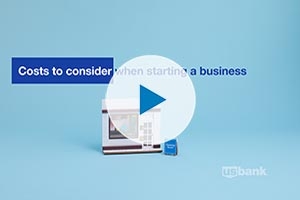Regardless of whether or not you’re pitching to investors and lenders, starting a business requires a plan. A business plan gives you direction, helps you qualify your ideas and clarifies the path you intend to take toward your goal.
Four important reasons to write a business plan:
- Decision-making: Business plans help you eliminate any gray area by writing specific information down in black and white. Making tough decisions is often one of the hardest and most useful parts of writing a business plan.
- A reality check: The first real challenge after deciding to launch a new venture may be writing the business plan. Through the process, you may realize your business idea is a bit flawed or not yet fully developed. This may feel like extra work, but the effort you put into improving your idea during this step can bolster your chance of future success.
- New ideas: Discovering new ideas, different approaches and fresh perspectives are invaluable parts of the business planning process. Working closely with your concept can lead to unexpected insights, shifting your business in the right direction.
- Developing an action plan: Your business plan is a tool that will help you outline action items, next steps and future activities. This living, breathing document shows where you are and where you want to be, with the framework you need to get there.
Business plan guide: How to get started
Use this exercise to gather some of the most important information. When you're ready to put an outline together, follow our standard business plan template (PDF) and use this business plan example to use as a guide as you fill in your outline. Once your outline is finalized, you can share it with business partners, investors or banks as a tool to promote your concept.
- Vision: Your vision statement sets the stage for everything you hope your business will accomplish going forward. Let yourself dream, pinpointing the ideas that will keep you inspired and motivated when you hit a bump in the road.
- Mission: A mission statement clarifies the purpose of your business and guides your plan, ultimately answering the question, "Why do you exist?"
- Objectives: Use your business objectives to define your goals and priorities. What are you going to accomplish with your business, and in what timeframe? These touchstones will drive your actions and help you stay focused.
- Strategies: Your objectives describe what you’re going to do, while your strategies describe how you’re going to do it. Consider your goals here, and identify the different ways you’ll work to reach them.
- Startup capital: Determine what your startup expenses will be. Having a clear idea will allow you to figure out where the money is coming from and help you spend what you have in the right areas.
- Monthly expenses: What do you estimate your business’ ongoing monthly expenses will be? This may change significantly over time — consider what your expenditure could be immediately after launch, in three months, in six months and in one year.
- Monthly income: In order to cover your expenses (and hopefully make a profit), you will need to estimate your income. What are your revenue streams? It's always wise to diversify your income. That way, you won’t be tied to one stream that might not be lucrative as quickly as you need it to be.
- Goal-setting and creating an action plan: Once you have all the specifics outlined, it's time to set up the step-by-step action items explained in the companion guide, a standard business plan outline. This process will utilize the hard work you've already done, breaking each step down in a way that you can follow.
A business plan isn’t necessarily a static document that you create once and then forget about. You can use it as a powerful tool by referencing it to adjust your priorities, stay on track and keep your goals in sight.
Business plan: An outline
Use this exercise to gather important information about your business.
Answer these questions to start your planning process. Your responses will provide important information about your business, which you can use as an overview to develop your plan further.
Vision
- What is your dream?
- What do you feel inspired to do or create?
- What keeps you motivated, even in the face of uncertainty?
Mission
- Why does this business exist?
- What purpose(s) or need(s) does it fulfill for customers?
Objectives
- List the goals of your company, then number them in order of importance.
- What will the business accomplish when it’s fully established and successful?
- How much time will it take to reach this point?
Strategies
- For each goal or objective listed above, write one or more actions required to complete it.
Startup capital
- List any and all startup expenses that come to mind.
- Next to each:
- Estimate the cost of any expenses you can.
- List the most likely source of the funding.
- Circle the high-priority expenses.
- Assess whether your available capital is going toward the high-priority items. If not, reconsider the way you will allocate funds.
Monthly expenses
- If you can, estimate your business’ ongoing monthly expenses immediately after launch, in three months, in six months and in one year.
- If you can’t, what information will you need in order to estimate your expenses?
Monthly income
- What are your revenue streams? Estimate your monthly income accordingly.
- Which revenue sources deliver fast or slow returns? Are there other sources you could consider to diversify assets?
Next steps
Learn how U.S. Bank can support you and your business needs at usbank.com/small-business.











































